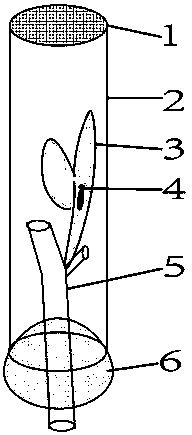Monitoring raising pipe for tea lesser leafhoppers and use method
A technology of small tea leafhoppers and feeding tubes, which is applied in animal husbandry and other fields, can solve the problems of heavy workload, small green leafhoppers, and limited nutrition of tea branches, and achieve the effect of reducing the degree of damage and facilitating observation
- Summary
- Abstract
- Description
- Claims
- Application Information
AI Technical Summary
Problems solved by technology
Method used
Image
Examples
Embodiment 1
[0020] 20 round transparent glass tubes with a length of 7cm and a diameter of 1.5cm with openings at both ends 2 ( figure 1 ), one end with 100 mesh gauze 1 ( figure 1 ) sealed to make 20 monitoring feeding tubes.
[0021] Select 20 young green leafhopper nymphs of the first instar hatching and put them in monitoring feeding tubes, one for each monitoring feeding tube. Select the potted Fuyun No. 6 tea tree with more tea buds and put it in the glass greenhouse, and select tea buds with a height of about 1.5cm 3 ( figure 1 ), cut off the surrounding excess tea branches and leaves to form figure 1 The drawn shape. Then the monitoring feeding tube containing nymphs was quickly covered with tea buds, and the bottom was covered with cotton 6 ( figure 1 ) fixed on tea branch 5 ( figure 1 )superior. The temperature in the glass greenhouse is maintained at 26-28°C, the relative humidity is 60%-80%, and the natural photoperiod.
[0022] The results show that more than 90% of th...
Embodiment 2
[0024] Use the monitoring feeding tube cover that introduces in embodiment 1 to raise little green leafhopper adults on the tea buds of about 3cm of the potted Narcissus tea tree, and each tube raises one to two. The breeding process is carried out in a glass greenhouse with a temperature of 26-28°C, a relative humidity of 60%-80%, and a natural photoperiod.
[0025] The records show that the tea buds in the tube were fed by adults for an average of 6 days before the buds fell off. At this time, the tea buds were slowly pulled out from the tube stuffed with cotton, so that the small green leafhoppers that were feeding on the buds had time to leave the tea buds, and then picked another healthy tea bud. Put the tube on the tea buds, fix the monitoring feeding tube on the hard branch with cotton, and continue to raise it.
Embodiment 3
[0027] Get 5 sexually mature unmated green leafhopper male and female adults, and put the male and female pairs into the monitoring feeding tube described in Example 1. Each tube is placed on a potted narcissus tea bud about 3 cm long, and the monitoring feeding tube is covered with cotton. The bottom is tightly plugged with tea sticks, and then the mating situation of paired adults in each tube is observed. This experiment was carried out in a glass greenhouse with a temperature of 26-28°C, a relative humidity of 60%-80%, and a natural photoperiod.
[0028] Records show that the mating time of the little green leafhopper is from 17 to 24 o'clock, and the mating time is 30 to 150 minutes. After the mating is completed, each tube of adults continues to be raised for three days to allow the females to lay eggs on the tea buds. After three days, the adults are taken out, and the tea buds continue to be entangled with the monitoring feeding tube. After about 7 days, it can be obs...
PUM
 Login to View More
Login to View More Abstract
Description
Claims
Application Information
 Login to View More
Login to View More - R&D
- Intellectual Property
- Life Sciences
- Materials
- Tech Scout
- Unparalleled Data Quality
- Higher Quality Content
- 60% Fewer Hallucinations
Browse by: Latest US Patents, China's latest patents, Technical Efficacy Thesaurus, Application Domain, Technology Topic, Popular Technical Reports.
© 2025 PatSnap. All rights reserved.Legal|Privacy policy|Modern Slavery Act Transparency Statement|Sitemap|About US| Contact US: help@patsnap.com


